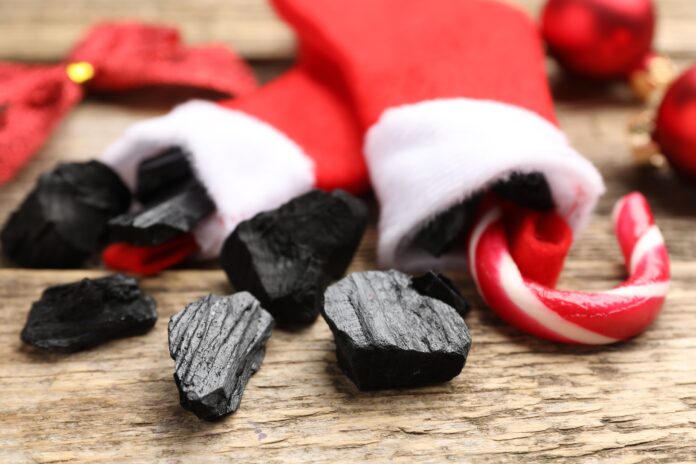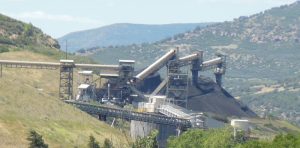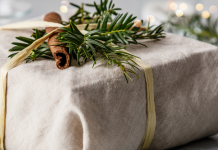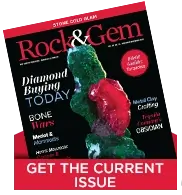
Coal or diamonds – what’s in my stocking? It’s the season of commercials advertising gifts of diamonds and stories of naughty children whose stockings will be filled with coal—the perfect season to take a closer look at carbon-based minerals, what they are, how they form and where they come from.
Carbon Minerals Around Us
From graphite to peat, to coal and even diamonds, let’s explore carbon-based minerals and a few of their uses. You may be surprised how many holiday stocking stuffers and everyday items contain some form of carbon.
Carbon is the second most common element in the human body (22.85%) after oxygen and it is the only element that has an entire branch of chemistry devoted to it. It is the 4th most abundant element in the universe by mass and the 15th most abundant element in the Earth’s crust.
Graphite: Stable Carbon
One of the oldest carbon-based minerals is graphite – one of the most stable forms of carbon. It can be natural or synthetic. It is a Mohs hardness of 1 to 2. In its natural form, it can be crystalline, flakes, lumps or even fibrous. Although not perfect, it is a good conductor of heat and electricity.
Graphite electrodes are essential and the main component in electric arc furnaces used to melt down scrap metal in the production of steel. Granular activated carbon is used in sugar refining to decolorize and remove impurities in the sugar. It is used as a carbon filter in respirators and water production and as a colorant in ink for printing as well as in pencil lead. Graphite is also a critical component in the production of batteries. In lithium-ion batteries, it serves as the anode, the battery’s negative terminal and provides stability and a longer life; it accounts for 10-20% of the battery’s weight.
Stocking Filler: In 2015, U.S. households purchased approximately $4.5 billion in batteries. The holidays could be a bust without the proper battery.
Peat: The First Step
Peat is the accumulation of partially decayed vegetation and organic matter. It is probably the first step in the formation of fossil fuels like coal. It forms in wetlands, just below the surface, where flooding or stagnant water blocks the flow of oxygen and slows the rate of decomposition over thousands of years.
Peat can be found all over the world. It is mostly found in northern latitudes but some deposits are even found as far south as the Falkland Islands. Traditionally, it is cut by hand, dried and used as a fuel source to heat homes.
You may not find a peat product in your holiday stocking, but if you live in an area that produces peat, or you can purchase it at a local Irish festival, you may enjoy peat’s distinctive smell in your fireplace this holiday season.

Coal: From Peat to Rock
Coal is where carbon-based minerals get more complicated. It is a combustible brown-to-black sedimentary rock.
Coal is peat that has been heated and hardened by underground pressure over millions of years. There are several different grades or categories of coal—lignite, bituminous coal and anthracite coal. Each grade of coal requires an increasing level of heat and pressure to form.
Lignite: Brown Coal Basics
Lignite, in Latin, lignum “wood,” also referred to as ‘brown coal’ is soft compressed peat with a carbon content of 25 to 35% and a high moisture content. It’s found worldwide and is used for steam-electric power generation. It is found in thick beds near the earth’s surface. When burned, it releases more carbon dioxide for the amount of heat it generates and depending on its mining origin, can contain toxic metals and naturally occurring radioactive materials making it harmful to human health. You may, however, see it in your stocking as a beautiful pendant as the gemstone jet. Although jet is considered a gemstone, it is not a mineral because it is actually wood that has undergone extreme pressure and has a Mohs hardness rating between 1 and 3.
Bituminous: Black Coal
Bituminous, or black coal, is the most abundant coal on earth, found in rocks of the Carboniferous age. It has a carbon content of approximately 84% and a Mohs hardness rating of 2.5 to 3. It is found deep in the earth, subjected to greater pressures and heated to 185°F or higher during its formation. This type of coal is the most dangerous to mine as it releases ‘firedamp,’ a dangerous mix of gases capable of causing underground explosions. It’s used most often for electrical power generation and in the steel industry.
Anthracite: Hard Coal
Anthracite is a hard, compact, black coal and has the highest carbon content of 86-97%. It was subjected to high pressures and temperatures of 340-480°F during its formation and has a Mohs rating of 3 to 4. Northeastern Pennsylvania has the largest known deposits in the world; however, China has the highest production, followed by Russia, Ukraine, North Korea, South Africa, Vietnam, Australia, Canada as well as other locations in the U.S. In 2020, 615 million tons of anthracite were produced worldwide. Anthracite is hard to ignite and burns with a short, blue, smokeless flame. One term used to describe it is “black diamond,” although it is a common misconception that diamonds form from highly compressed coal.

James St. John, Creative Commons Attribution 2.0, via Wikimedia Commons
Diamonds: Carbon’s Gem
Now in gemstone territory, diamonds are a solid form of carbon. They are tasteless, odorless, and have the highest Mohs hardness rating of 10. Of all the carbon-based minerals, diamonds are the oldest, anywhere from 1 to 3.5 billion years old. They form at the deepest levels of the earth’s magma, 93-155 miles to 500 miles below the surface, under extreme pressure and heat over 2,000°F.
Diamonds are carried to the surface in volcanic eruptions and found in kimberlite pipes. On rare occasions, diamonds have formed at the Earth’s surface because of a meteor strike. Their formation is much more complicated than can be described here. They are found in different sizes, colors and grades—from flawless gemstones to materials used in industrial tools.
Nearly 49% of the world’s diamonds come from Central and South Africa. There are also sources in Canada, India, Russia, Brazil and Australia. In the U.S., they have been found in Colorado, New Mexico, Wyoming, Montana and Arkansas.
At Crater of Diamonds in Arkansas, for a fee of $15, you can dig and sift in the over-turned ground and keep what you find.
Trained staff in the visitors’ center can check your stones, and when a diamond is found, a loud horn is blown to alert everyone in the park. Over 75,000 diamonds have been found here over the year,s with an average of one or two each day.

(Sue Eyre)
Carbon’s Impact
Carbon also has byproducts like carbon dioxide, which can harm our world. The emissions from burning carbon-based fuels affect the air we breathe and the ozone layer that protects our entire planet.
Diamond mining also has a negative side, from unfair mining and selling practices to environmental impacts.
Coal Traditions
Parents have been threatening children for generations, “If you don’t behave, Santa will leave coal in your stocking.” While coal can be a holiday threat, in other cultures it is a traditional gift.
In the Scottish tradition of Hogmanay, “first footing” says that the first person to cross your home’s threshold after midnight on New Year’s Eve should bear gifts of coal to warm your home, a coin to bring prosperity, cake to ensure your family has enough food for the year and whisky for good libations.
Carbon Fibers in Products
Carbon fibers also make up many holiday wish list items. Carbon fibers are used in products because they are strong and lightweight. There is a good chance your wish list may include an item that contains carbon fibers: a fishing rod, bicycle, tennis racket, golf club, softball bat, hockey stick, or maybe even a high-end luxury sports car or boat.
Coal or Diamonds in Your Stocking?
Carbon is everywhere. It’s in our bodies, the air we breathe and the everyday products we use like shampoo, lotion, toothpaste and deodorant. It is even used to make the sugar in our holiday candy. So, what will be in your stocking? You may find it hard to receive any holiday gift NOT containing some form of carbon.
This story about coal and carbon minerals previously appeared in Rock & Gem magazine. Click here to subscribe. Story by Sue Eyre.















